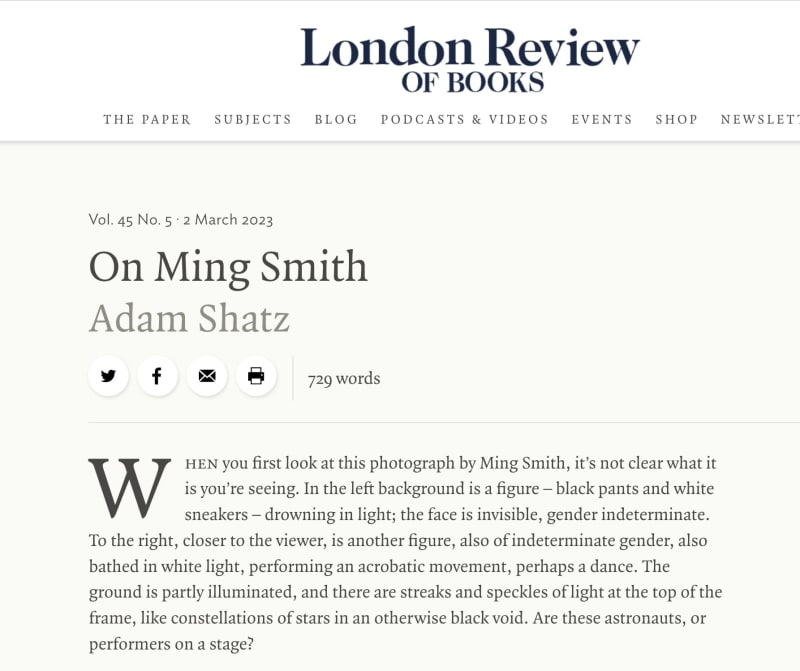When you first look at this photograph by Ming Smith, it’s not clear what it is you’re seeing. In the left background is a figure – black pants and white sneakers – drowning in light; the face is invisible, gender indeterminate. To the right, closer to the viewer, is another figure, also of indeterminate gender, also bathed in white light, performing an acrobatic movement, perhaps a dance. The ground is partly illuminated, and there are streaks and speckles of light at the top of the frame, like constellations of stars in an otherwise black void. Are these astronauts, or performers on a stage?
In a way, they’re both. The subjects of Smith’s photograph Julius + Joanne, taken in 1981, are Julius Hemphill, an avant-garde saxophonist and composer, and Joanne Robinson-Hill, a dancer and choreographer. They’re collaborating on a duet, probably in one of the Downtown loft spaces to which free jazz musicians migrated in the 1970s: at the very bottom of the image we can see the top of someone’s head. But Hemphill and Hill are also flying in unknown territory, where, in the words of Sun Ra (another Smith subject), ‘space is the place.’ In this black void, under those white lights, Hemphill and Hill resemble kinetic apparitions in the cosmos. Smith’s photograph captures the moment of exploration where, as the poet Thulani Davis writes, ‘the sound becomes/a shape, a dance, a/configuration of what/we know that we have/not seen or heard.’
Smith was 31 years old when she took this picture, and already well on her way to becoming the foremost photographer of her generation’s Black bohemia, especially its musicians. (She was briefly married to the tenor saxophonist David Murray, Hemphill’s bandmate in the World Saxophone Quartet.) Raised in Columbus, Ohio, she settled in New York City in the early 1970s, after studying microbiology at Howard University. While modelling to make ends meet, she became the only female member of the Black photographers’ collective Kamoingz and the first Black woman to have her work acquired by the Museum of Modern Art, which is currently staging the exhibition Projects: Ming Smith (until 29 May).
Like her contemporary Nan Goldin, Smith was a part of the scene she photographed, and was less interested in documenting it than in depicting its specific moods and textures, and her own responses to it. (That she’s far less well-known than Goldin is an indication of how little interest the art world had, until recently, in Black subjects.) She often compares herself to a blues or jazz musician. ‘If people could feel what I feel when I hear a Billie Holiday song,’ she says, ‘that’s what I would want them to feel when they look at my work.’ There’s sometimes a melancholy in her photographs of Black life, but it’s offset by the same ironical awareness that infuses the blues. Smith has said she admires August Wilson’s ability to make his working-class characters ‘monumental’ and she achieves similar effects, whether she’s photographing jazz royalty or an unknown man in a Pittsburgh pool hall.
Smith’s photographs (unlike Goldin’s images of white hipsters) are never invasive; nor do they dwell on signs of material poverty or suffering. The subjects of her portraits are often concealed by an out-of-focus blur. This blur is her most recognisable – and beguiling – technique. She achieves it, she says, by keeping the shutter open while holding the camera very still and hardly breathing. The filmmaker Arthur Jafa argues that the blur is an act of resistance, circumventing ‘the ability of photography to function as evidence’ since ‘you can’t identify anybody.’ According to Jafa, Smith is exercising her Black subjects’ ‘right to opacity’: their freedom from the scrutiny of white society. In Julius + Joanne, her subjects are simply bodies in motion, repositories of light.
But Smith is also defending her own right to abstraction, to an expressiveness and lyricism that go beyond documentation. This is where her work comes closest to the music of composers such as Hemphill, for whom the exploration of sound and ‘extended’ instrumental techniques are as important as melody or harmony. Smith remembers being told that she was ‘circular breathing’ while taking one of her blurred images. She approaches light as if it were sound, and it is the most elusive of her subjects.

